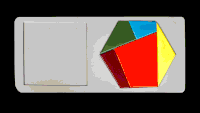
Area is the measure of a region's size on a surface. The area of a plane region or plane area refers to the area of a shape or planar lamina, while surface area refers to the area of an open surface or the boundary of a three-dimensional object. Area can be understood as the amount of material with a given thickness that would be necessary to fashion a model of the shape, or the amount of paint necessary to cover the surface with a single coat. It is the two-dimensional analogue of the length of a curve or the volume of a solid . Two different regions may have the same area ; by synecdoche, "area" sometimes is used to refer to the region, as in a "polygonal area".
A perimeter is a closed path that encompasses, surrounds, or outlines either a two dimensional shape or a one-dimensional length. The perimeter of a circle or an ellipse is called its circumference.

Samuel Loyd was an American chess player, chess composer, puzzle author, and recreational mathematician. Loyd was born in Philadelphia but raised in New York City.

The tangram is a dissection puzzle consisting of seven flat polygons, called tans, which are put together to form shapes. The objective is to replicate a pattern generally found in a puzzle book using all seven pieces without overlap. Alternatively the tans can be used to create original minimalist designs that are either appreciated for their inherent aesthetic merits or as the basis for challenging others to replicate its outline. It is reputed to have been invented in China sometime around the late 18th century and then carried over to America and Europe by trading ships shortly after. It became very popular in Europe for a time, and then again during World War I. It is one of the most widely recognized dissection puzzles in the world and has been used for various purposes including amusement, art, and education.

A tessellation or tiling is the covering of a surface, often a plane, using one or more geometric shapes, called tiles, with no overlaps and no gaps. In mathematics, tessellation can be generalized to higher dimensions and a variety of geometries.

The missing square puzzle is an optical illusion used in mathematics classes to help students reason about geometrical figures; or rather to teach them not to reason using figures, but to use only textual descriptions and the axioms of geometry. It depicts two arrangements made of similar shapes in slightly different configurations. Each apparently forms a 13×5 right-angled triangle, but one has a 1×1 hole in it.

Henry Ernest Dudeney was an English author and mathematician who specialised in logic puzzles and mathematical games. He is known as one of the country's foremost creators of mathematical puzzles.

In recreational mathematics, a polyabolo is a shape formed by gluing isosceles right triangles edge-to-edge, making a polyform with the isosceles right triangle as the base form. Polyaboloes were introduced by Martin Gardner in his June 1967 "Mathematical Games column" in Scientific American.

In geometry, a square pyramid is a pyramid with a square base, having a total of five faces. If the apex of the pyramid is directly above the center of the square, it is a right square pyramid with four isosceles triangles; otherwise, it is an oblique square pyramid. When all of the pyramid's edges are equal in length, its triangles are all equilateral, and it is called an equilateral square pyramid.

Tiling puzzles are puzzles involving two-dimensional packing problems in which a number of flat shapes have to be assembled into a larger given shape without overlaps. Some tiling puzzles ask players to dissect a given shape first and then rearrange the pieces into another shape. Other tiling puzzles ask players to dissect a given shape while fulfilling certain conditions. The two latter types of tiling puzzles are also called dissection puzzles.
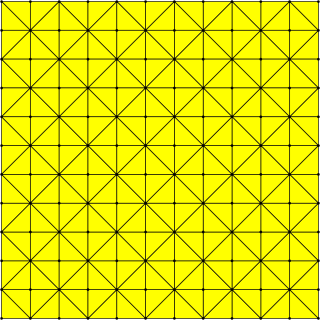
In geometry, the tetrakis square tiling is a tiling of the Euclidean plane. It is a square tiling with each square divided into four isosceles right triangles from the center point, forming an infinite arrangement of lines. It can also be formed by subdividing each square of a grid into two triangles by a diagonal, with the diagonals alternating in direction, or by overlaying two square grids, one rotated by 45 degrees from the other and scaled by a factor of √2.
In geometry, a dissection problem is the problem of partitioning a geometric figure into smaller pieces that may be rearranged into a new figure of equal content. In this context, the partitioning is called simply a dissection. It is usually required that the dissection use only a finite number of pieces. Additionally, to avoid set-theoretic issues related to the Banach–Tarski paradox and Tarski's circle-squaring problem, the pieces are typically required to be well-behaved. For instance, they may be restricted to being the closures of disjoint open sets.
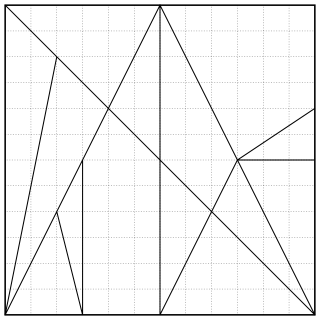
In ancient Greek geometry, the Ostomachion, also known as loculus Archimedius or syntomachion, is a mathematical treatise attributed to Archimedes. This work has survived fragmentarily in an Arabic version and a copy, the Archimedes Palimpsest, of the original ancient Greek text made in Byzantine times.

In geometry, a square trisection is a type of dissection problem which consists of cutting a square into pieces that can be rearranged to form three identical squares.

In the geometry of tessellations, a rep-tile or reptile is a shape that can be dissected into smaller copies of the same shape. The term was coined as a pun on animal reptiles by recreational mathematician Solomon W. Golomb and popularized by Martin Gardner in his "Mathematical Games" column in the May 1963 issue of Scientific American. In 2012 a generalization of rep-tiles called self-tiling tile sets was introduced by Lee Sallows in Mathematics Magazine.

In geometry, a hinged dissection, also known as a swing-hinged dissection or Dudeney dissection, is a kind of geometric dissection in which all of the pieces are connected into a chain by "hinged" points, such that the rearrangement from one figure to another can be carried out by swinging the chain continuously, without severing any of the connections. Typically, it is assumed that the pieces are allowed to overlap in the folding and unfolding process; this is sometimes called the "wobbly-hinged" model of hinged dissection.

A self-tiling tile set, or setiset, of order n is a set of n shapes or pieces, usually planar, each of which can be tiled with smaller replicas of the complete set of n shapes. That is, the n shapes can be assembled in n different ways so as to create larger copies of themselves, where the increase in scale is the same in each case. Figure 1 shows an example for n = 4 using distinctly shaped decominoes. The concept can be extended to include pieces of higher dimension. The name setisets was coined by Lee Sallows in 2012, but the problem of finding such sets for n = 4 was asked decades previously by C. Dudley Langford, and examples for polyaboloes and polyominoes were previously published by Gardner.
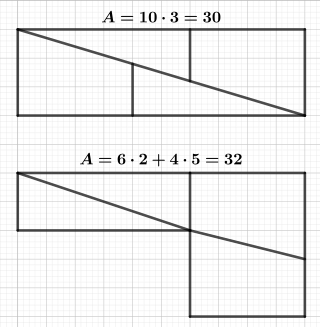
Hooper's paradox is a falsidical paradox based on an optical illusion. A geometric shape with an area of 32 units is dissected into four parts, which afterwards get assembled into a rectangle with an area of only 30 units.
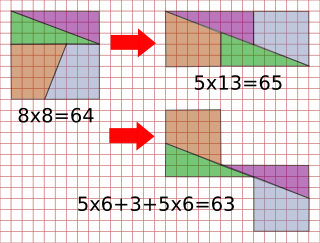
The chessboard paradox or paradox of Loyd and Schlömilch is a falsidical paradox based on an optical illusion. A chessboard or a square with a side length of 8 units is cut into four pieces. Those four pieces are used to form a rectangle with side lengths of 13 and 5 units. Hence the combined area of all four pieces is 64 area units in the square but 65 area units in the rectangle, this seeming contradiction is due an optical illusion as the four pieces don't fit exactly in the rectangle, but leave a small barely visible gap around the rectangle's diagonal. The paradox is sometimes attributed to the American puzzle inventor Sam Loyd (1841–1911) and the German mathematician Oskar Schlömilch (1832–1901).

A vanishing puzzle is a mechanical optical illusion comprising multiple pieces which can be rearranged to show different versions of a picture depicting several objects, the number of which depending on the arrangement of the pieces.




